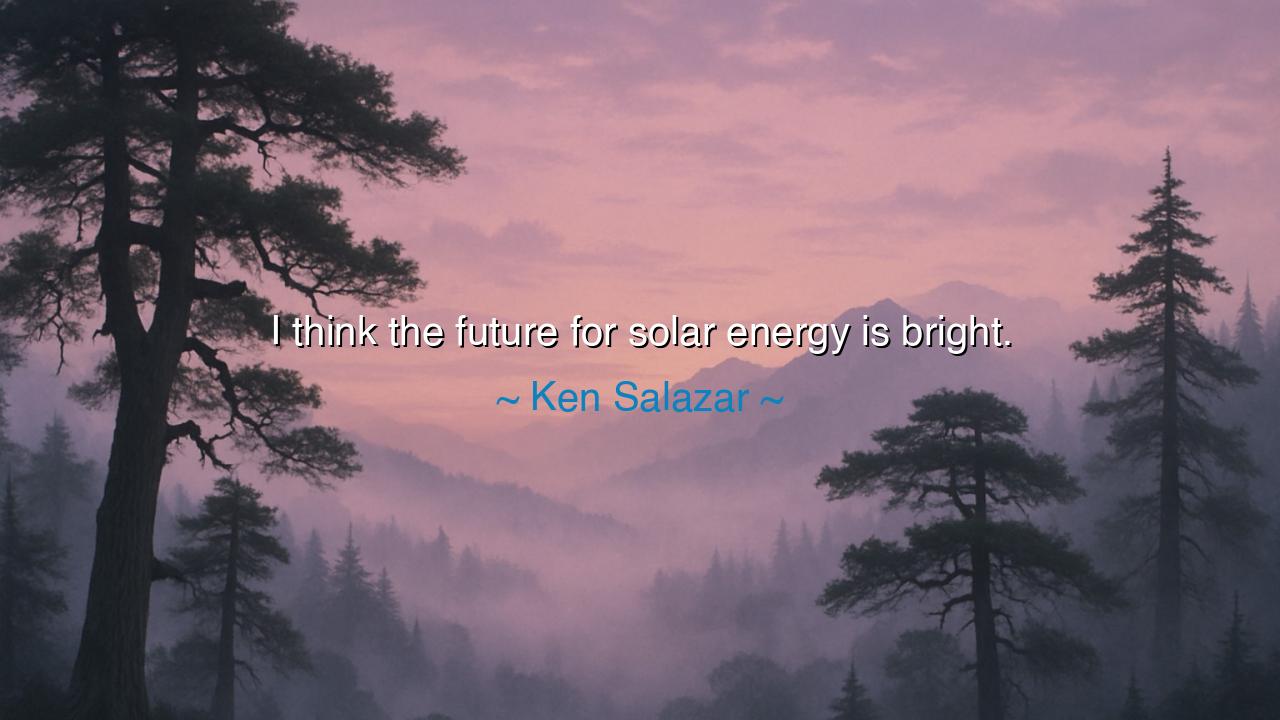
I think the future for solar energy is bright.






Hear the sentence that shines like a proverb beneath the noonday sky: “I think the future for solar energy is bright.” In these few words, Ken Salazar threads hope through history. He points to the old star that has warmed every harvest and steered every voyage, and says: the sun that has always been our patron may yet become our partner. The saying carries a double radiance—poetry and physics—reminding us that the light which paints the mountains each morning can also power the loom, the school, the kiln, and the home.
The ancients raised stones to track solstices, measuring time by shadows; the moderns raise panels to catch photons, measuring power by kilowatt-hours. Thus the meaning of the quote is not mere wordplay on bright—it is a vow that civilization can move from burning the past to harvesting the present. Where fire once demanded forests and coal, solar energy asks only for open sky and careful craft. Day by day, the future brightens as we learn to turn scattered light into steady work, to save noon for midnight with clever storage, and to weave many small roofs into a resilient grid.
Mark a story worthy of the annals. In a village once yoked to kerosene—dear, dim, and dangerous—a small array of rooftop modules and a communal battery changed the night. Students studied without smoke; the clinic ran a vaccine fridge; a seamstress kept her machine humming past dusk. Bills fell; fires fell; the stars seemed nearer because the room no longer burned to see them. No dam was needed, no pipeline laid—only sunlight gathered, electrons guided, and a community taught to steward its own power. Here the proverb proves its lineage in lives: the future grew bright one roof at a time.
History gives a second lantern. When Bell Labs unveiled a practical photovoltaic cell in 1954, the device was a curiosity fit for satellites, not cities. Yet each decade brought quieter miracles: materials refined, costs lowered, inverters matured, storage learned to hold the day for the evening meal. Nations that dared to scaffold their grid with solar energy saw smog retreat, fuel imports ease, and blackouts shrink. The lesson is austere and joyful: the sun writes us a check each dawn; technology teaches us how to cash it without bankrupting the Earth.
The quote’s origin is also political courage. It is the voice of a steward saying industry and ecology need not be enemies: deserts can host shimmering fields; warehouses can grow electric skin; parking lots can shade cars while feeding towns. The bright future is not utopia; it is procurement rules, interconnection standards, training programs, and markets that pay fairly for the cleanest watt—the watt we never waste and the watt we make from light.
Let the teaching be carved into daily bread: solar energy is civilization remembering its oldest covenant—live by the sky, not by the graveyards of ancient sunlight. We honor that covenant when we pair panels with efficiency; when we add storage so hospitals and homes stand calm in storms; when we design grids that welcome many small sources instead of fearing anything that isn’t colossal. The future grows bright not by rhetoric, but by roofs, wires, and work.
Carry these actions like tools at dawn. (1) Start with efficiency—seal, insulate, and light wisely; the cheapest watt is the one you do not use. (2) Harvest locally—put panels on homes, schools, and shops; consider community arrays where roofs are few. (3) Add storage—from home batteries to thermal tanks, so sunlight serves both lunch and midnight. (4) Modernize the rules—support policies that speed interconnection, reward flexibility, and value clean power in the price you see. (5) Train hands and minds—technicians, electricians, planners—so opportunity spreads with the light. (6) Pair with nature—agrivoltaics that raise both crops and current, pollinator habitats beneath arrays, reflective roofs that cool the city noon. Do these with steady cheer, and Salazar’s oracle will no longer be prediction but description: the future for solar energy is bright because we chose to make it so, and the sun, patient as ever, met us halfway.






AAdministratorAdministrator
Welcome, honored guests. Please leave a comment, we will respond soon